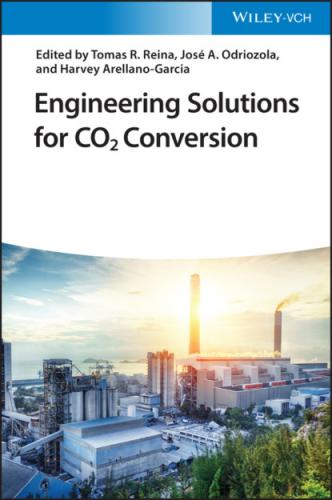(3.14)
Apart from the reactions described above, some undesired reactions might also occur in the process as WGSR, carbonaceous materials, Boudouard reaction, and bulk carbide formation.
The synthesis of methanol and methane can also be derived from the syngas [115]. Methanation and methanol can be performed directly from the syngas or by CO2 hydrogenation. The main reactions for both syntheses are described below. For both processes, WGSR plays an important role and affects the selectivity to the final products.
Power to methane.
1 (a) CO2 + 4H2 → CH4 + 2H2O
2 (b) CO + 3H2 → CH4 + H2O
3 (c) CO + H2O → CO2 + H2
Power to methanol.
1 (a) CO2 + 3H2 → CH3OH + H2O
2 (b) CO + 2H2 → CH3OH
3 (c) CO + H2O → CO2 + H2
Furthermore, products obtained from the Fischer–Tropsch reaction and methanol can also be recombined with syngas, CO, or H2 to obtain different products highly valued in the chemical industry. Some examples for different products are, for instance, ethanol to gasoline reaction by means of zeolites [116, 117]; hydroformylation reaction of olefins with syngas to aldehydes, and alcohols with cobalt and rhodium catalysts [118]; carbonylation reactions [119], where CO from the electrolysis can be employed; and methanol plus syngas or carbon monoxide, for the synthesis of value‐added chemicals [117].
The important role of electrolysis as a bridge between renewable energies, energy storage technology, and value‐added products (chemicals, fuels, etc.) is therefore obvious. The combination in the same step of both technologies, CO2 co‐electrolysis to produce syngas and the production of hydrocarbons by Fischer–Tropsch process, will give rise to a more efficient, compact, and environmental friendly technology. The eCOCO2 project [120] (sponsored by the EU commission via the H2020 program) based on CO2 conversion focuses on the development of co‐ionic electrochemical cells, which enable both: the electrolysis of water and the hydrocarbon synthesis in the same step. The CO2 converter consists of electrochemical cell constructed with a co‐ionic electrolyte that allows the injection of protons to the reaction cell, and the simultaneous extraction of oxygen ions. In addition, a multifunctional catalyst will be integrated in the electrochemical cell for the hydrocarbon generation. The final objective of this project is the production of more than 250 g of jet fuel per day.
3.5.3 Other Applications
3.5.3.1 Methane Steam Reforming
The feasibility of performing SMR using the proton‐conducting material BaZr0.7Ce0.2Y0.1O2.9 (BZCY72) was successfully examined at low temperatures (450–650 °C) under atmospheric pressure by M. Stoukides and coworkers [121]. The system exhibited strong dependence on gas concentration, temperature, and applied voltage, as well as excellent chemical stability.
In 2017, J.M. Serra, C. Kjølseth, and colleagues reported an outstanding breakthrough regarding the production of pure hydrogen from methane. A protonic membrane reformer (PMR) electrochemically driven capable of realizing four process steps simultaneously, achieving near‐zero energy loss (see Figure 3.8a). The reformer is made out of a dense proton‐conducting layer of BaZr0.8–x–y CexYyO3−δ (BZCY), sandwiched between two porous electrodes (BZCY and Ni) [122]. Figure 3.8b represents the PMR concept, where methane is reformed with steam (H2O) to produce hydrogen that is subsequently transported through the membrane and finally compressed as a consequence of the applied voltage. The study reported full methane conversion permeating 99% of the produced hydrogen at 800 °C. The permeated hydrogen was electrochemically compressed up to 50 bar.
Figure 3.8 (a) Representation of the four chemical steps. (b) Protonic membrane reformer.
Source: Malerød‐Fjeld et al. [122].
Figure 3.9 Co‐ionic catalytic membrane reactor.
Source: Morejudo et al. [125].
3.5.3.2 Methane Dehydroaromatization
A clear example of the contribution of membranes toward chemical production and process intensification is the direct conversion of methane‐containing sources, i.e. natural gas or biogas, into valuable petrochemicals using MDA reaction [123]. This reaction, normally carried out at 700 °C, suffers from some drawbacks, and rapid catalyst deactivation occurs because of the accumulation of polyaromatic‐type coke, impeding the access to the catalyst‐active sites and the limitation imposed by thermodynamics of the per‐pass conversion to aromatics [124]. In order to overcome the abovementioned disadvantages, a recent publication reports a CMR for MDA process intensification [125]. The system is composed of an electrochemical BaZrO3‐based tubular membrane that exhibits proton and ion conductivity. Figure 3.9 depicts a representation of the MDA reaction and the different components/materials that form the CMR.
In this case, methane is converted to benzene and hydrogen using a Mo/H‐MCM‐22 catalyst. Protons are transported to the sweep side, whereas oxide ions are transported to the reaction chamber and react with H2 to form water that will subsequently react with coke to form CO and H2, enhancing catalyst stability. The authors observed that the electrochemically driven simultaneous extraction and injection of proton and oxide ions, respectively, allows obtaining high aromatic yields while drastically reducing the catalyst deactivation rate by coking.
3.6 Conclusions and Final Remarks
Membrane technologies are striking as strong candidates to tackle climate change by presenting potential and effective solutions for capturing
